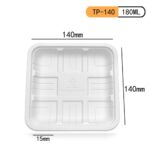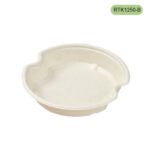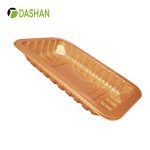Introduction
PP Food Packaging is one of the most widely used solutions in today’s food industry, valued for its balance of durability, food safety, cost-effectiveness, and environmental potential. Made from polypropylene (PP), this packaging type can handle a wide range of temperatures, resist chemical corrosion, and be fully recyclable under the right conditions. From takeaway lunch boxes and soup bowls to salad containers and bakery trays, PP food packaging supports both commercial efficiency and consumer convenience.
In a global market increasingly driven by sustainability goals and regulatory requirements, PP food packaging stands out as a material capable of reducing waste, supporting recycling, and maintaining food quality throughout its shelf life.

1. Understanding PP (Polypropylene) Food Packaging
Polypropylene is a thermoplastic polymer produced from the polymerization of propylene monomers. It has a semi-crystalline structure, which gives it excellent mechanical strength while maintaining lightweight properties.
Key Technical Properties:
-
Melting Point: 130–170°C (ideal for microwave heating)
-
Density: ~0.90 g/cm³ (lighter than PET, PVC, or PS)
-
Moisture Resistance: Near-zero water absorption
-
Recyclability: Classified under resin identification code #5
-
Chemical Inertness: No reaction with acids, bases, or oils found in foods
Because of these characteristics, PP food packaging can be designed for both single-use and reusable purposes, offering flexibility to foodservice operators.
2. Advantages of PP Food Packaging
| Feature | Benefit in Food Applications |
|---|---|
| Microwave & Dishwasher Safe | Allows reheating and reuse without warping |
| High Impact Resistance | Maintains integrity during transport |
| Lightweight Design | Lowers shipping costs and carbon footprint |
| Leak-Proof Options | Snap-on lids and tight seals for liquid foods |
| Customizable | Can be tinted, printed, or embossed for branding |
| Recyclable | Supports closed-loop sustainability models |
3. Common Applications of PP Food Packaging
a) Takeaway & Delivery Packaging
-
Microwave-safe lunch boxes for reheating meals
-
Soup bowls that retain shape even when hot-filled at 95°C
-
Bento boxes for portion control and presentation
b) Fresh Produce & Deli Counters
-
Clamshell fruit containers with ventilation holes
-
Salad bowls with transparent lids for display
-
Vegetable trays with compartment dividers
c) Bakery & Confectionery
-
Cake domes that prevent moisture loss
-
Muffin trays that resist oil penetration
-
Chocolate boxes with food-safe coatings
d) Beverage Packaging
-
PP cups for bubble tea and iced coffee
-
Cold drink tumblers with straw lids


4. PP Food Packaging in the Sustainability Context
Many people think only PET has a strong recycling profile, but PP is quickly catching up.
According to the American Chemistry Council, post-consumer PP recycling grew 5% year-on-year in 2023 thanks to improved sorting technologies and investment in advanced recycling plants.
Sustainability Benefits:
-
Lightweight = less fuel in transport → lower CO₂ emissions
-
Closed-loop recycling → old PP containers can be turned into new food-grade packaging
-
Lower production energy demand compared to some other plastics
5. Industry Trends & Market Data
-
Global PP Food Packaging Market Size (2024): USD 64 billion (Source: Grand View Research)
-
Projected CAGR (2024–2030): 5.1% driven by takeaway and meal prep demand
-
Reusable PP Packaging Growth: Accelerating due to bans on certain single-use plastics in the EU, Canada, and parts of Asia
-
Customization Demand: Over 40% of restaurants now require brand-printed PP containers to strengthen identity
6. Regulatory & Safety Compliance
PP food packaging must meet strict food-contact regulations:
-
FDA (U.S.): Compliant for all food types under 21 CFR 177.1520
-
EU Regulation (EC) No 1935/2004: Safe for repeated contact with food
-
China GB 4806.7-2016: National standard for plastic food containers
-
Migration Testing: Ensures no harmful substances leach into food during use
7. Expert Insight
“PP food packaging is uniquely positioned to bridge performance and sustainability. With closed-loop systems, it can match PET in recyclability while outperforming it in thermal stability for hot food.”
— Dr. Laura Kim, Materials Scientist, Packaging Research Institute
8. Case Study – Xiamen Dashan’s PP Food Packaging Solutions
At Xiamen Dashan, PP food packaging is a core product category.
Our strengths include:
-
Diverse Product Range: Lunch boxes, fruit trays, salad bowls, soup cups, bakery domes
-
Customization: Logos, embossing, and unique shapes for brand recognition
-
Compliance: FDA, EU, and GB standards certified
-
Sustainability: Production in ISO 9001 facilities with waste reduction programs
-
Export Expertise: Serving markets in North America, Europe, Australia, and Southeast Asia


9. Frequently Asked Questions
Q1: Is PP Food Packaging microwave safe?
Yes, it can withstand microwave heating without releasing harmful substances.
Q2: Is PP recyclable everywhere?
Recycling availability varies by region, but acceptance is expanding.
Q3: Does PP affect food flavor?
No, PP is inert and odorless.
Q4: Is PP better than PET for hot food?
Yes, PP handles higher temperatures without deforming.
Conclusion
PP Food Packaging delivers performance, safety, and sustainability in one package. With its heat resistance, recyclability, and adaptability, it’s an ideal choice for modern foodservice, retail, and meal prep businesses. As global recycling systems improve, PP will become a leading force in creating a circular packaging economy while meeting the demands of convenience-driven consumers.
References
-
American Chemistry Council – Polypropylene Recycling Report 2023 – https://www.americanchemistry.com
-
Grand View Research – Polypropylene Food Packaging Market Size Report – https://www.grandviewresearch.com/
-
FDA – Food Contact Substances Regulations – https://www.fda.gov/
-
European Commission – Food Contact Materials – https://health.ec.europa.eu/
-
PlasticsEurope – Polypropylene Facts – https://plasticseurope.org/
Copyright Statement© 2025 Dashan Packing. All rights reserved.
This article is an original work created by the Dashan Packing editorial team.All text, data, and images are the result of our independent research, industry experience,and product development insights. Reproduction or redistribution of any part of this contentwithout written permission is strictly prohibited.
Dashan Packing is committed to providing accurate, evidence-based information andto upholding transparency, originality, and compliance with global intellectual property standards.





